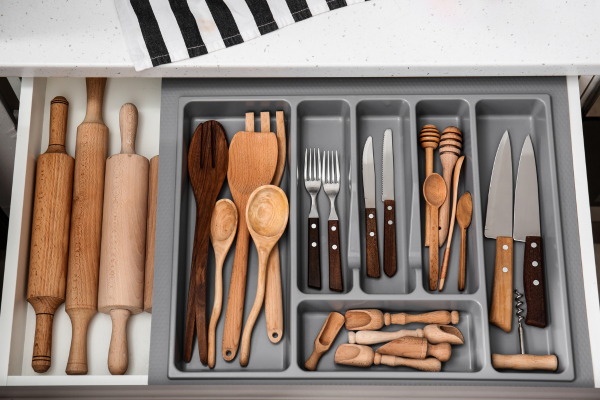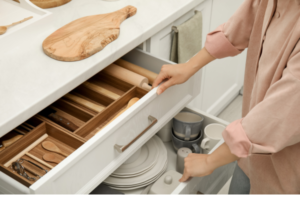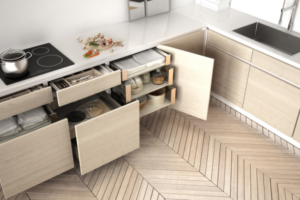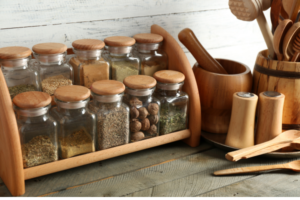Introduction
A well-organized kitchen is more than just a pleasing aesthetic; it’s the heart of culinary creativity and efficient meal preparation. However, achieving an organized kitchen involves more than tidying up countertops. One of the critical elements of a functional kitchen is the proper organization of utensils. From spatulas and ladles to knives and measuring cups, utensils play a pivotal role in cooking. This article explores tips and strategies to maintain an orderly and efficient kitchen by properly storing utensils.
Importance of Organizing Utensils
An organized kitchen not only streamlines meal preparation but also contributes to a stress-free cooking experience. Imagine needing a specific utensil urgently, only to rummage through drawers or cabinets, disrupting the cooking flow. Properly organized utensils eliminate this hassle and save valuable time during meal prep. Moreover, a clutter-free kitchen allows for a clear workspace, enhancing safety and reducing the risk of accidents.
Assess Your Utensils
Before diving into the organizational process, take inventory of your kitchen utensils. Sort through them and identify what you frequently use versus items that rarely see the light of day. This initial assessment will help streamline the organizing process by enabling you to prioritize the essential utensils that need easy access. Consider donating or discarding items you seldom use to declutter and make room for more crucial tools.
Utilize Drawer Dividers
Drawer dividers are an excellent tool for organizing utensils in kitchen drawers. They segment the drawer space, allowing you to categorize utensils according to their function or size. For instance, designate a section for spatulas, another for ladles, and a separate one for measuring spoons. This separation not only keeps utensils neatly arranged but also makes it easier to locate specific items quickly.
Wall-Mounted Racks and Magnetic Strips
Maximize vertical space by installing wall-mounted racks or magnetic strips. These solutions not only free up drawer space but also provide easy access to frequently used utensils. Wall-mounted racks with hooks can accommodate pots, pans, and larger utensils, while magnetic strips securely hold knives and metal tools, keeping them within arm’s reach without cluttering countertops.
Utilize Hanging Baskets or Hooks
Hanging baskets or hooks offer another efficient way to organize utensils, especially those that may not fit into drawers or cabinets easily. Hang baskets from the ceiling or under cabinets to store items like colanders, sieves, and larger utensils. Hooks attached to walls or cabinet doors can hold mugs, ladles, or even pots and pans, freeing up additional storage space.
Label and Categorize
Create a systematic approach to organizing utensils by labeling and categorizing storage spaces. Labels help maintain order by ensuring that each utensil finds its designated place. Use labels or tags on drawers, baskets, or dividers, categorizing items based on their use or function. This method streamlines the retrieval process, saving time and effort while cooking.
Consider Drawer Inserts and Organizers
Drawer inserts and organizers come in various shapes and sizes, offering customizable solutions to fit different utensils. These tools help keep items neatly arranged, preventing them from shifting around when opening or closing drawers. Use adjustable drawer dividers to create sections tailored to specific utensils, ensuring a snug fit and easy access.
Store According to Frequency of Use
Arrange utensils based on their frequency of use. Keep frequently used items within easy reach, either on countertops in designated containers or in easily accessible drawers. Less frequently used utensils can be stored in less accessible areas or higher cabinets, freeing up prime space for essential tools.
Utilize Unused Spaces
Make use of underutilized spaces in your kitchen for storing utensils. The insides of cabinet doors, the sides of refrigerators, or the space above cabinets are often overlooked but can be repurposed for hanging hooks, racks, or magnetic strips. These spaces provide additional storage options without encroaching on precious countertop or drawer space.
Regular Maintenance and Decluttering
Regular maintenance is key to sustaining an organized kitchen. Set aside time periodically to reassess your utensils, ensuring that the organization system still meets your needs. Declutter by removing items that have become redundant or unused over time. This practice prevents accumulation and maintains the efficiency of your kitchen space.
Conclusion
An organized kitchen is the cornerstone of a seamless cooking experience, and properly storing utensils is integral to achieving this organization. By employing these strategies—utilizing drawer dividers, wall-mounted racks, hanging baskets, labeling, and thoughtful categorization—you can transform your kitchen into a functional and efficient space. Remember, the key lies in assessing your needs, optimizing available space, and maintaining regular upkeep. With these tips, you’ll not only streamline meal preparation but also enhance your overall kitchen experience.
In conclusion, a well-organized kitchen contributes significantly to a stress-free cooking environment. Properly storing utensils not only saves time but also enhances safety and efficiency in meal preparation. By implementing these strategies, your kitchen can become an inviting space where culinary creativity flourishes and cooking becomes a joyous activity.



